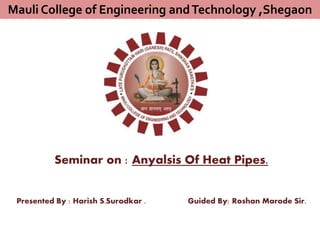Heat Pipe
- 1. Seminar on : Anyalsis Of Heat Pipes. Presented By : Harish S.Surodkar . Guided By: Roshan Marode Sir. Mauli College of Engineering andTechnology ,Shegaon
- 3. ÔÇ° Introduction ÔÇ° Literature Review ÔÇ° Components of a heat pipe ÔÇ° Working ÔÇ° The prime requirements ÔÇ° Construction ÔÇ° Types ÔÇ° Application ÔÇ° Advantages ÔÇ° Conclusion ÔÇ° References
- 4. ÔÇ° A heat pipe is a device that efficiently transports thermal energy from its one point to the other. ÔÇ° It utilizes the latent heat of the vaporized working fluid instead of the sensible heat. ÔÇ° As a result, the effective thermal conductivity may be several orders of magnitudes higher than that of the good solid conductors.
- 5. ÔÇ° The concept of the heat pipe was first introduced by Gaugler in 1942 (Dunn and Reay, 1982). According to Gaugler, the objective of his invention was "to cause absorption of heat, or in other words evaporation of the liquid to a point above the place where the condensation or giving off heat takes place without expending upon the liquid any additional work to lift the liquid to an elevation above the point at which condensation takes place". A capillary structure was proposed as the means for returning the liquid from the condenser to the evaporator.
- 8. ÔÇ° The first consideration in the identification of the working fluid is the operating vapor temperature range. ÔÇ° Within the approximate temperature band, several possible working fluids may exist and a variety of characteristics must be examined in order to determine the most acceptable of these fluids for the application considered.
- 9. ÔÇ° Compatibility with wick and wall materials ÔÇ° Good thermal stability ÔÇ° Wettability of wick and wall materials ÔÇ° High latent heat ÔÇ° High thermal conductivity ÔÇ° Low liquid and vapor viscosities ÔÇ° High surface tension
- 10. ÔÇ° Cylindrical Heat Pipes ÔÇ° Vapor chamber or flat heat pipes ÔÇ° Variable Conductance Heat Pipes (VCHPs) ÔÇ° Diode Heat Pipes ÔÇ° Loop heat pipe
- 11.  The working principle, the fluid flow and heat transfer mechanism are similar in any heat pipe (irrespective of the shape).  Niobium, Zirconium and Tungsten were the container materials used.  The working substances used were Lithium, Lead, Bismuth and Barium.  The temperature range selected was between 1500°C and 2000°C for the operation of their heat pipes
- 13. ÔÇ° Thin planar heat pipes (heat spreaders) have the same primary components as tubular heat pipes. ÔÇ° Heat input to the evaporator vaporizes liquid, which flows in two dimensions to the condenser surfaces. ÔÇ° After the vapor condenses on the condenser surfaces, capillary forces in the wick return the condensate to the evaporator.
- 16. ÔÇ° Where the intake or exhaust air ducts must be rerouted extensively, the benefits are likely not to offset the higher fan energy and first cost. ÔÇ° Use of heat pipe sprays without careful water treatment. Corrosion, scale and fouling of the heat pipe where a wetted condition can occur needs to be addressed carefully. ÔÇ° Laptop heat pipe solution. ÔÇ° Heat pipes used in processor and CPU. ÔÇ° Space craft
- 17. ÔÇ° Passive heat exchange with no moving parts. ÔÇ° Relatively space efficient. ÔÇ° The cooling or heating equipment size can be reduced in some cases. ÔÇ° The moisture removal capacity of existing cooling equipment can be improved. ÔÇ° No cross-contamination between air streams.
- 18. ÔÇ° Heat pipe is a thermal super conductor under certain heat transfer condition they can transfer the heat energy 100 times more than available best conductive materials, because of negligible temp. Gradient exist in heat pipe. ÔÇ° The heat pipe has compactness, light weight, reversible in operation and high thermal flux handling capability makes heat pipe to use new modern era and in many wide varient application to overcome critical heat dissipation problem.
- 19. ÔÇ° www.google.com ÔÇ° www.wikipedia.com ÔÇ° www.studymafia.org ÔÇ° www.heatpipe.com ÔÇ° www.indek.com
Editor's Notes
- #3: 2



















